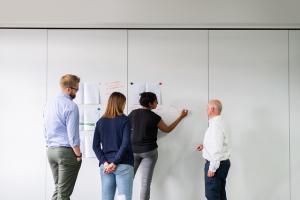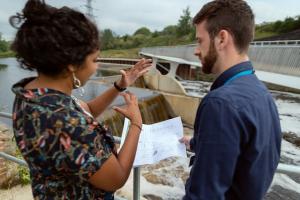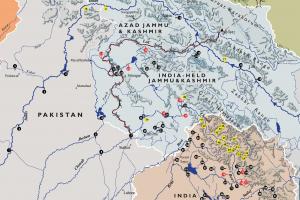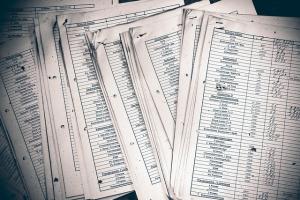Engineering Mechanics
- Concept of measurement of mass, force, time and space, system of units, Fundamental & Derived units, conversion of units, required accuracy of results
- General Principles of static’s, Vector addition, subtraction and products,
- Resultant of distributed (linear & non linear) force systems,
- General conditions of equilibrium of co-planer forces, Laws of triangle, parallelogram and polygon of forces,
- Types of Beams, supports and loads, simple cases of axial forces, shear forces and bending moment diagrams,
- Problem involving friction on flat surfaces
- Geometrical properties of plane areas
- Work, energy, power, impulse, momentum, conservation of momentum and energy
- Rectilinear and curvilinear motions, Tangential and normal components of Acceleration, Simple harmonic motion
Engineering Mechanics Lab
- Roof Truss
- To find the various forces in various parts of wall crane
- To verify the line of polygon on various forces
- To find coefficient of friction between various materials on inclined plan
- To verify the principle of moment in the disc apparatus
- Helical block
- To draw a load efficiency curve for a screw jack
|
|
Books Recommended
Engineering Mechanics
4th edition by Irving H. shames, Prentice Hall
|
 Ask a Question about Engineering Mechanics Ask a Question about Engineering Mechanics
Engineering Mechanics Questions Answers
|
View Lectures
Lectures Notes of Engineering Mechanics - Coming Soon
|
Engineering Drawing 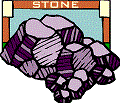
- Introduction:
- Drawing Instrument & their use.
- Types of lines & letters.
- Scales
- Dimensions & their Types.
- Planning of a Sheet.
- Types of Engineering Drawings.
- Geometric Constructions & Engineering Curves, Parabola, Ellipse & Hyperbola.
- Projections:
- Concept of Projection.
- Types of Projections, Orthographic Projection.
- 1st Angle & 3rd Angle Projection
- Orthographic Projection of Points, Simple lines, simple planes & simple solids.
- Three Views of an object.
- Sectional Views.
- Isometric Views from given orthographic Views.
- Free Sketches. Of solid objects & building drawings.
- Building Drawings.
- Building symbols.
- Types of building drawings, proposed drawing, submission drawing, Working drawing & completion drawing.
- Introduction to Bridge Drawings.
- Engineering Drawing
- Drawing Exercises:
- Planning of sheet & practicing lines & letters.
- Orthographic Projections of given model, Sectional Views.
- Steel Structure Connections detail.
- Preparation of Plan, Elevation & Section of Single story simple buildings.
- Isometric & other three dimensional View
- Free Hand Sketches.
|
|
Books Recommended
- Essentials of Drafting by James D. Bethune.
- Engineering Drawing by N.D. Butt.
|
 Ask a Question about Engineering Drawing & Drafting Ask a Question about Engineering Drawing & Drafting
Engineering Drawing & Drafting Q's n Answers
|
View Lectures
Engineering Mechanics, 4th edition by Irving H. shames, Prentice Hall
|
Computer Applications in Civil Engg. & Communications
Part – A: Computer Applications
- Introduction to Computer Hardware
- Introduction to Operating Systems
- Introduction to Word Processors
- Introduction to Spread Sheets
- Introduction to Presentation Software
Part – B: Communication Skills
- Brain Storming Process
- Analysis of Topic
- Audience Analysis
- Sequencing the Presentation Material
- Detailing of Material
- Preparing Conclusion
- Question & Answer Sessions
- Preparation of Presentation in Software
- Presentation to Audience
- Participating in seminars and interviews
- Presenting Conference Papers
|
|
Books Recommended
- Mastering OfficeXP, by Gini Cortrte
- Communication Skills ,University of Phoenix
|
 Ask Question about Civil Softwares Ask Question about Civil Softwares
Civil Engineeirng Softwares Answers
|
View Lectures
Engineering Mechanics
|
| |
Applied Linear Algebra
- Vector Algebra:
- Introduction to scalars and vectors, Vectors in the plane, Scalar and vector products, Lines in R2, R 3 and planes, Spheres, Orthogonal projections, Perpendicular distance from a point to a line and a plane, Vector spaces, Subspaces, Linear combinations, Linearly dependent and Independent set of vectors, Spanning of a vector spaces, Bases of a vector spaces and its applications in engineering and Business.
- Matrix Algebra:
- Introduction to matrices, Matrix operations, Inverse Matrix, Rank of a Matrix, Echelon form of a Matrix and its applications in our daily life situation problems, i-e in line-communication as Air-lines, Telephone-lines, Connecting cities by roads.
- Determinants:
- Determinants and its properties, Inverse of a matrix, Rank of a matrix, linearly dependent and independent by determinants.
- Linear system of equations:
- Independent, Dependent and Inconsistent system of equations and its graphical representation, Trivial and non-trivial solutions of homogeneous system of linear equations and its applications as linear models in Business, Economics, Science, Electric Circuits and other branches of engineering. Solution of linear system of equations by determinants and its applications as Leontief input-output matrix of the economy, Coding and decoding theory.
- Linear Transformations:
- Reflection operators, Projection operators, Rotation operators, Shear in x and y directions, Dilation and Contraction.
- Eigenvalues and Eigenvectors:
- Eigenvalues and eigenvectors and its applications as deformation, Markov processes as Mass-transit problems, Forecasting of weather and to develop the solution of the system of differential equations for mechanical system/electrical system and civil engineering, especially in public health engineering problems.
|
|
Books Recommended
David C Lay, Linear Algebra and its Application,
2nd Edition, Addison-Wesley Publication Jan 1998
|
 Ask a Question about Civil Engineering Ask a Question about Civil Engineering
Civil Engineering Questions Answers
|
View Lectures
Engineering Mechanics, 4th edition by Irving H. shames, Prentice Hall
|
|
|
Electrical Technology
- Power Systems layout, generation, transmission, distribution and utilization of electric power
- Electrical Elements and circuits
- Electrical current, voltage, power, energy, Ohm’s law, inductance, capacitance, Kirchoffs laws. Introduction to node voltage and loop current methods.
- Principle of House wiring and Industrial wiring
- Diode Transistor and simple rectifier circuit.
- Electrical know how related to experimental design instrumentations like corrosion rate measurements, strain gauges, LDT’s LVDT’s. etc.
|
|
Books Recommended
Theraja, B.L. Electrical Technology,
S. Chand (21st or 26th edition)
|
 Ask a Question about Civil Engineering Ask a Question about Civil Engineering
Civil Engineering Questions Answers
|
View Lectures
Engineering Mechanics
|
|
|
Semester - 2 Syllabus & Courses
|
- Simple stress and strain
- Types of stresses and strains
- Load extension diagram for different materials
- Hooke’s law, Modulus of elasticity
- Lateral and volumetric strain. Poisson’s ratio
- Temperature stresses and compound bars
- Theory of torsion of solid and hollow circular shafts
- Advanced cases of shear force and bending moment diagrams for statically determinate beams. Relationship between Load, Shear and Moment.
- Theory of simple bending, Neutral Axis, Resisting moments and section modulus.
- Shear stresses in mono-symmetric beams
- Deflection of beams by double integration, moment area and conjugate beam methods
Mechanics of Solids Lab
- Investigation of Hook’s law that is the proportional relation between force and stretching in elastic deformation,
- Determination of torsion and deflection,
- Measurement of forces on supports in statically determinate beam,
- Determination of shear forces in beams,
- Determination of bending moments in beams,
- Measurement of deflections in statically determinate beam,
- Measurement of strain in a bar
- Bend test steel bar;
- Yield/tensile strength of steel bar;
|
|
Recommended Books
- Strength of Materials by Andrew Pytel & Ferdinand L. Singer
- Mechanics of Materials by E.P. Popov
|
 Ask a Question about Mechanics of Solids Ask a Question about Mechanics of Solids
Mechanics of Solids Questions Answers
|
View Lectures
Mechanics of Solids - Strength of Materials
|
- Introduction to Programming & Visual Basic
- Visual Basic Code Components
- Data Types
- Variables
- Control Structures
- Procedures
- Arrays
- File I/O operations
Lab
- Visual Basic Code Components (program examples)
- Data Types (program examples)
- Variables (program examples)
- Control Structures (program examples)
- Procedures (program examples)
- Arrays (program examples)
- File I/O operations (program examples)
- Programming related to Civil Engineering
- Matrix addition, subtraction and multiplication.
- Beam analysis program for simply supported, cantilever, Overhanging Beam
- Program for finding resultant of forces and its angle
- Program for stress analysis of composite bar
|
|
Recommended Books
- Visual Basic 6 by Deitel & Deitel, T.R. Nieto
- Visual Basic.NET by Deitel & Deitel, T.R. Nieto
|
 Ask a Question about Engineering Mechanics Ask a Question about Engineering Mechanics
Engineering Mechanics Questions Answers
|
View Lectures
VB.Net for Civil Engineering
|
- Cements, Ceramics, and Refractories:
- Manufacture, properties, and application of lime, cement, ceramic and bricks
- Mortars and concrete, Pozzolanic material, effects of various chemicals on cement and concrete. Methods of protection, strength and test of building stone. Quarrying and dressing of stone.
- Timbers:
- Varieties and uses of important timbers, method of seasoning and sawing Decay, seasoning and preservation of timber, laminated materials.
- Glass and Plastics:
- Composition, varieties, properties and use of glass, plastic, laminates and adhesive.
- Metals:
- Composition and properties of ferrous and non ferrous metals used in civil engineering. Effect of various heat treatments on the properties of steel and its alloys. Corrosion and methods of corrosion control. Properties of thermal insulation material for use in buildings.
- Paints and Varnishes:
- Composition, preparation, properties, test and uses of paints, plasters, varnishes and distempers.
- Other Materials:
- Acoustical material and geo-textiles, properties and uses of asphalt, bitumen, rubber and asbestos, laminates and adhesive.
Lab
- Gradation of coarse aggregate
- Gradation of fine aggregate
- Fineness of cement
- Setting time
- Normal Consistency
- Initial Setting time
- Final Setting time
- Tensile Strength of Briquette
- Compressive strength of mortar cube
- Soundness test of Cement
- Density of Cement
- Slump Test
|
|
Recommended Books
- Neville A. Properties of Concrete, English Language Book Society
- Smith R. C. Material of Construction, McGraw-Hill
|
 Ask a Question about Engineering Materials Ask a Question about Engineering Materials
Engineering Materials Questions Answers
|
View Lectures
Engineering Materials Lectures
|
Calculus
- Single Variable Calculus:
- Basic concepts of single variable function, Continuous, discontinuous and piecewise continuous functions, Periodic, odd and even functions, algebraic functions, Transcendental functions and its graphical representations, Applications of functions in our daily life situations.
- Differential Calculus:
- Limits and continuity, Interpretation of a derivative, Geometric interpretation, Total differential and its applications in our daily life situations, The use of a table of different type derivatives, Higher order derivatives, Tangents and normals, Approximation of a function at a particular point by Taylor's and Maclaurin's series, Maximum and minimum values of a function, The first derivative test, The second derivative test, Point of inflexion and its applications in business and engineering.
- Integral Calculus:
- Basic concepts of integration, A table of integral formulas, Some rules of integration, Definite integrals, The area bounded by a curve, Integration by parts, Integration as the limit of a sum, Volume of revolution, and its applications in our daily life situations
- Multivariate Calculus:
- Basic concepts of multivariate function, Level curves and surfaces, Limits and continuity, Partial differentiation, Geometric interpretation, higher partial derivatives. Tangent planes, Total differential, Vector functions and its differentiation and integration, The directional derivative, The gradient, Scalar and Vector fields, Normal property of the gradient, Divergence , Curl, Tangent planes and normal lines, Extrema of functions of two variables, Second partials test, Extreme value theorem, Method of Constrained optimization and Lagrange multipliers.
|
|
Recommended Books
- Robert Davison, Addison Wesley, Mathematics for Engineers
- Antom, H. Calculus and Analytic Geometry, Johney Wiley and Sons.
- Toff and Mckay, Practical Mathematics
- S.A.H.Rizvi, Engineering Mathematics
|
 Ask a Question about Civil Engineering Ask a Question about Civil Engineering
Civil Engineering Questions Answers
|
View Lectures
Engineering Mechanics
|
| |
- Introduction to Geology
- Importance of Geology for Civil Engineering Projects
- Physical properties and identification of common rocks forming minerals
- Rocks formation and classification:
- According to the mode of occurrences
- According to the Silica contents
- Weather and erosion:
- Weather classification, fresh, slightly weathered, moderately weathered etc.
- Discontinuity classification:
- Joints, faults and other fractures, micro structural features, such as lamination, cleavages, foliations, spacing of discontinuities as close, wide, medium etc,
- Description of Rock masses as thickly bedded or thinly bedded
- Identification of filling in joints, sand clay and breccias etc
- Color of grains, description with respect to the rock color and identification as a course grained, hardness classification as soft with respect to test
- Geological classification and identification of Rocks by geological names
- Identification and subordinate constitutions in rocks samples such as seams or branches of other types of minerals for example, Dolomite, Lime stone, Calcareous sand stone, sand.
- Classification of Durability of Rocks in Dry and wet condition with durability test
- Engineering and physical properties of rocks
- Geological technical properties of rocks used as building stones, as a decorated stones and as a industrial rocks such as color, luster, streak, specific gravity, water absorption and unit weight etc.
- Brief Introduction to structural Geology:
- Plate Tectonics with respect to the global application, earthquakes, causes of earthquakes, protective measures against earthquakes and zoning of earth quakes in Pakistan
- Role of geology in selection of sites for dams, reservoirs, tunnels and other civil engineering structures
- Brief introduction of local geology
|
- Analysis of stresses and strains at a point due to combined effect of axial force, shear force and bending moment
- Mohr’s circle for stresses and strains
- Relationship between elastic constants
- Theories of Failure
- Unsymmetrical Bending
- Shear Stresses in mono-symmetric beams
- Shear stress distribution in unsymmetrical beams
- Shear flow, shear center, concentration of stresses
- Thick and thin walled cylinders
- Analysis of curved beams and beams on elastic foundation
- Short eccentrically loaded columns
- Core of a section
- Rankine Gordon formula for intermediate columns, slenderness ratio
- Eccentrically Loaded Columns
- Inelastic behavior of beams in flexure
- Shape factor of a section.
|
|
Recommended Books
- Strength of Materials by Andrew Pytel & Ferdinand L. Singer
- Mechanics of Materials by E.P. Popov
|
 Ask a Question about Mechanics of Solids Ask a Question about Mechanics of Solids
Mechanics of Solids Questions Answers
|
View Lectures
Solid Mechanics Lectures
|
- Building Construction:
- Site Selection for a building, Orientation and Setting out for construction
- Layout Techniques:
- Layout Techniques with special reference to buildings. Excavation in different types of soils
- Masonry construction
- Types of stone and brick masonry; bonds in brick masonry, Alignments, Plumbs, leveling & cambering.
- Form work
- Form work for general in-situ construction, props, bracing and horizontal shuttering platforms.
- Damp proofing in building, Interior and exterior surface finishes
- Various types of floors & roofing systems, planner & non-planer roofing system, roof treatments.
- Expansion joints and construction joints
- Wood work in building construction
- Other Engineering Projects.
- An over view of construction aspects of different types of engineering projects, e.g. buildings, retaining structures, bridges
- Construction specification
- Common defects in building construction their causes and remedial measures
Lab
- Architectural Drawings, Structural Drawings, Plumbing and Electrical Work.
- Computer Aided Drawing (AutoCAD)
General and basic know how related to computer aided drafting, e.g., coordinate system, drawing setup procedure, basic draw commands, basic edit commands; Layers, creating test and defining styles options, block and drawing import/export options; Cross hatching, save and plot (2D) and isometric drawings. Use of Auto CAD in drawing plans, elevation and section of single and double-storey buildings
|
- INTRODUCTION TO STRUCTURAL ANALYSIS:
- Definition of structure, types of structures: pin jointed and rigid jointed. Types of structural members. Types of beams, supports and loads. Stability of structures. Redundancy. Determinate and indeterminate structures, Degree of indeterminacy. Sign conventions for bending moment and shear force etc.
- ANALYSIS OF STATICALLY DETERMINATE RIGID JOINTED PLANE FRAMES:
- Definition. Analysis of determinate frames.
- ANALYSIS OF DETERMINATE PLANE TRUSSES:
- Definition and common types of trusses. Classification of co-planar trusses. Methods of analysis of trusses; Method of joints, Method of sections, Graphical method.
- ROTATIONS AND DEFLECTIONS:
- Deflection diagrams and elastic curves. Castigiano’s theorem for trusses beams and frames. Unit load method. Theorem of virtual work for trusses beams and frames.
- ARCHES:
- Definition. Linear arch. Eddy’s theorem. Three hinged parabolic and circular arch. Bending Moment and shear force diagrams. Influence lines for shear, thrust and moment.
- INFLUENCE LINES:
- Definition. Influence lines for statically determinate beams and paneled girders.
- Influence lines for reaction, shear and bending moment of statically determinate beams and paneled girders. Influence lines for axial forces in trusses. Influence lines for composite structures.
- TRAVELLING LOADS:
- Maximum bending moment and shear force at any section. Criterion for maximum moment and shear.
- Absolute maximum bending moment.
- CABLES AND SUSPENSION BRIDGES:
- Cables. Stiffened suspension bridges with three hinged stiffening girders.
- Shear force and bending moment diagrams.
- THREE MOMENT EQUATION:
- Derivation of 3-moment equation. Application of 3-moment equation to the analysis of indeterminate beams
Labs
- Demonstration of various types of structures and supports.
- Demonstrate the stability of structures using model structures.
- Determination of the horizontal thrust and maximum bending moment in a three hinged parabolic arches.
- Determination of the horizontal thrust and maximum bending moment in a two hinged parabolic arches.
- Determination of the deflections and rotations in overhanging beams.
- Demonstration of influence line
- Investigation of the buckling struts
- Determination of shear cente
|
Recommended Books
- Wang, C.K. Intermediate Structural Analysis, McGraw Hill
- West, H.H. Analysis of Structures, John Wiley & Sons.
- Hibbeler, R.C. Structural Analysis, Prentice Hall.
|
 Ask a Question about Structural Engineering Ask a Question about Structural Engineering
Structural Analysis Questions Answers
|
View Lectures
Structural Analysis Lectures
|
Town Planning & Architecture
-
Architecture
-
Historical Development
-
General introduction to history of architecture; Emergence/Development of Islamic Architechure.
- Influences
- Geographical, climatic, religious, social, historical.
- Principles
- Truth or purpose & beauty.
- Qualities
- Strength, vitality, grace, breadth and scale.
- Factors
- Proportion, color and balance.
- Use of Materials
- Stone, wood, metals, concrete, composites, ceramics.
- General Treatment to Plan of Buildings
- Walls and their construction; Openings and their position, character and shape; Roofs and their development and employment; Columns and their position, form and decoration; Molding and their form decoration, Ornament as applied to any buildings.
- Town Planning Definitions
- Trends in urban growth; Objectives of town planning; Modern planning in Pakistan and abroad.
- Preliminary Studies
- Study of natural resources, economic resources, legal and administrative problems, civic surveys and preparation of relevant maps.
- Land Use Patterns
- Various theories of land use pattern. Location of Parks and recreation facilities, public and semi-public buildings, civic centers, commercial centers, local shopping centers, public schools, industry & residential areas.
- Street Patterns
- Lay out of street, road crossing & lighting; Community planning
- City Extensions
- Sub Urban development, Neighborhood Units, Satellite Town and Garden City
- Urban Planning
- Issues related to inner city urban design and emergence/up gradation of squatter settlements.
- Introduction to Urban & Regional Planning using GIS
|
Recommended Books
- Snyter, J.C. Introduction to Urban Planning, Milwaukee McGraw Hill Book Co
- Fletcher, S.B. A History of Architecture. The Athlone Press.
|
 Ask a Question about Town Planning Ask a Question about Town Planning
Town Planning Questions Answers
|
View Lectures
Town Plannig Lectures - Coming Soon
|
Mechanical Technology
- Basics of Thermodynamics
- Thermodynamic systems,
- Laws of thermodynamics,
- Laws of perfect gases
- Energy equation
- Internal Energy, Enthalpy and entropy of the working fluids
- Prime Movers:
- Internal combustion engines: type, working principle, cycle operation and performance,
- Steam Engines
- Steam Turbines
- Air-compressors
- Air-Conditioning:
- Introduction to Air-conditioning and refrigeration. Heating and cooling load and its calculations, comfort chart, outline of AC systems
Lab
- Practical # 1: To study the different components of petrol engine.
- Practical # 2: To study the cooling system of automobile engine.
- Practical # 3: To study the lubrication system of automobile engine.
- Practical # 4: To study the ignition system of automobile engine.
- Practical # 5: To study the fuel system of automobile engine.
- Practical # 6: To study the air-intake system of automobile engine.
- Practical # 7: To study the 2-Stroke Reciprocating Engine.
- Practical # 8: To study the vapor compression system.
- Practical # 9: To study different components of refrigeration and air-conditioning system.
- Practical # 10: The layout of boiler room.
- Practical # 11: To study the boiler of the steam engine power plant.
- Practical # 12: To study the steam Engine of the steam engine power plant.
- Practical # 13: To study the turbine of the steam engine power plant.
- Practical # 14: To study the condenser of steam engine power plant.
|
| |
Ordinary Differential Equations:
Basic concepts of ordinary differential equation, General and particular solutions, Initial and boundary conditions, Linear and nonlinear differential equations, Solution of first order differential equation by separable variables and its applications in our daily life situations, The techniques like change of variable, homogeneous, non-homogeneous, exact, non-exact, linear and nonlinear Bernoulli could be used in case of complications. Solution of second order differential equation by theory of operators and its applications as forced and free oscillations, The extension of second order solution criteria to higher order differential equations, Solution of the system of differential equations by theory of operators and its applications in our daily life situations.
Partial Differential Equations:
Basic concepts, Linear and nonlinear p.d.equations, Quasi linear and Quasi nonlinear p.d.equations, Homogeneous and non-homogeneous p.d.equations, Solutions of p.d.equations, Boundary and initial conditions as Dirichlet condition, Neumann condition, Robbins/Mixed condition, Classification of p.d.equations as Elliptic, Parabolic and Hyperbolic.
Analytic solution by separation of variables of the Steady-State Two-Dimensional Heat equation/Laplace equation and Unsteady-State One-Dimensional Heat equation/Diffusion equation with homogeneous and nonhomogeneous boundary conditions. D'Alembert's solution of Two-Dimensional Wave equation with homogeneous and nonhomogeneous boundary conditions.
Fourier Series:
Periodic waveforms and their fourier representations, Calculating a fourier series, Fourier series of odd and even functions, Half range fourier series, Fourier series solution for the above p.d.equations.
|
|
Recommended Books
- Kreyszig, E.Advanced Engineering Mathematics, Wayne and Erson.
- Abell & Braselton, Brooks /Cole, Modern Differential Equations, Second edition
|
 Ask a Question about Engineering Mechanics Ask a Question about Engineering Mechanics
Civil Engineering Questions Answers
|
Download Kreszig Solution
Differential Equations Solutions
|
- Introduction to fluid Mechanics & its classification.
- History of fluid Mechanics
- Application of Fluid mechanics in Civil Engineering.
- Distinction between solids and fluids.
- Physical Properties of Fluids:
- Density, Specific weight, Specific Volume, Specific gravity, Viscosity.
- Newton’s Law of viscosity. Surface tension. Compressibility of fluids.
- Fluid Statics:
- Static pressure, Pressure height relationship, absolute and gauge pressure,
- Measurement of Pressure, Barometer, Bourdon gauge, Pizometer tube, simple and differential manometer, Basic principal of various pressure measuring instruments.
- Forces on submerged plane and curved bodies. Buoyancy and Stability of submerged and floating bodies.
- Fluid Kinematics:
- Basics Concept about steady and unsteady flow, Laminar and Turbulent flow, Path lines, stream line, stream tube, uniform and non uniform flow.
- Basic Equations:
- Continuity Equation, Energy Equation and Momentum Equation.
- Application of Energy Equation and Continuity Equation to incompressible fluids.
- Fluid Measurement:
- Venturimeter, Orifices, Mouth pieces and Nozzles, pitot tube, Weirs and Notches.
- Flow through Pipes:
- Laminar Flow through pipes, Darcy’s Weisbach equation for flow through pipes,
- Hydraulic and Energy gradient lines, Losses in Pipe lines. Transmission of Energy through Pipes
- Flow through Open Channel:
- Uniform flow through open channels. Chezy’s and Manning’s formula for uniform Flow through open channels. Most efficient cross section of open channel.
Labs
- Demonstration of various parts of Hydraulic Bench.
- Experimental Study of laminar and turbulent Flow.
- Experimental Study of tube gauges and Dead weight pressure gauges.
- Calibration of Orifices by Various Methods.
- Calibration of venturimeter.
- Calibration of Rectangular and Triangular Notch.
- Verification of Bernoulli’s theorem.
- Determination of Metacentric height.
- Study of Various losses through Piping arrangements.
|
Recommended Books
- Robert L.Daughetn, Joseph B. Franzini, Fluid Mechanics with Engineering applications
- E.H.Lewitt, Hydraulics and Fluid Mechanics
|
 Ask a Question about Fluid Mechanics Ask a Question about Fluid Mechanics
Fluid Mechanics Questions Answers
|
View Lectures
Hydraulics & Fluid Mechanics
|
- Introduction
- Surveying instruments; chains, tapes, steel bands, their types & uses.
- Chain Surveying
- Ranging & Chaining of Survey lines. Field work & Plotting of Chain survey
- Compass Surveying
- Prismatic Compass& Surveyor compass
- Uses, Bearings, Local attraction, Fieldwork & Plotting.
- Plane Table Surveying
- Parts and accessories. Methods of surveying. Two-point and three-point problems.
- Leveling
- General principle. Types of levels and their temporary and permanent adjustments. Methods of levelling. Reduction of levels, Precise levelling and Trigonometric Leveling.
- Theodolite.
Types and uses of theodolites. Temporary and permanent adjustments. Measurement of horizontal and vertical angles.
- Tacheometrical surveying
- Methods of tacheometrical surveying. Field work and computation
-
Traversing
-
Traversing with prismatic compass, theodolite and plane table, computations and adjustments of traverse, transformation of Co-ordinates
-
Omitted Measurements
-
Calculation of Areas and Volumes
- Earthwork calculations. D.M.D. method, Simpson rule and trapezoidal rule.
Labs
- Practice on measurement of distances and introduction to measuring instruments
- Chain Surveying and plotting
- Compass Traversing
- Plane Table by methods of radiations and Intersections
- Two Points Problem
- Three Points Problem
- Level adjustments by two-peg method.
- Profile and Cross-Sectioning
- Theodolite traversing
|
Recommended Books
- Kavanash,B. Surveying principles and Application, Prentice Hall
- Irvine, W. Surveying for Construction, McGraw Hill.
- Davis, R.E. Surveying Theory and Practice, McGraw Hill
|
 Ask a Question about Surveying & Levelling Ask a Question about Surveying & Levelling
Engineering Surveying Questions Answers
|
View Lectures
Engineering Surveying
|
- Basic Concepts
- Introduction to Engineering Economics
- Time Value of Money
- Different Methods of Analysis (Present Worth Analysis, Annual Worth Analysis etc.)
- Concept of Internal Rate of Return & Its use in Engineering Projects
- Various Types of Costs (Maintenance, Repair, Other Overhead Costs etc. ) & Benefits & Its Use in Engineering Projects
- Economical Life of Construction Equipment
- Inflation
- Depreciation & Its Types
- Cost Escalation
- Introduction to Break Even Analysis & Its Application to Engineering Project
- Sensitivity Analysis
- Demand and Supply Analysis
- Theory of Pricing & Theory of Production and Laws of Return
- Funding, Funding Agencies and Planning Commission
- Types of Business Organizations
- Labor problems, Labor Organization, Prevention and Settlement of Disputes
|
Recommended Books
- Donald G. Newman
- E.Peul Degarmo
|
 Ask a Question about Engineering Economics Ask a Question about Engineering Economics
Engineering Economics Questions Answers
|
View Lectures
Engineering Economics Lecture Notes
|
- Method of Consistent Deformation:
- Analysis of statically indeterminate beams, frames and trusses. Castigliano's second theorem (Method of least work).
- Slope Deflection Method
- Derivation of equation, Analysis of continuous beams and portal frames without joint movement. Analysis of continuous beams and portal frames due to yielding of supports. Analysis of portal frames with joint movement. Analysis of closed frames and multistory portal frames.
- Moment Distribution Method
- Concept, Distribution and carry over factors, Analysis of continuous beams and portal frames without joint movement. Analysis of continuous beams and portal frames due to yielding of supports. Analysis of continuous beams and portal frames with joint movement. Analysis of multistory portal frames.
- Plastic Analysis
- Elastic versus Plastic Analysis in Steel Design, Upper & Lower Bound Theorems, Statical Moment & Mechanism Methods. Design of Beams, Propped Cantilever, Fixed ended & Continuous beams & frames, Design Examples
- Analysis of Arches
- Analysis of two hinged circular and parabolic arches with supports at different levels.
- Influence Lines for Indeterminate Beams
- Use of Clark Maxwell and Betti’s Theorm, Law of Reciprocal Deflections, Influence lines for moment and reactions in proposed cantilevers. Influence lines for support reaction of two and three span continuous beams. Influence lines for Shear Force and Bending Moment at any section of the beam.
|
Recommended Books
- Wang, C.K. Intermediate Structural Analysis, McGraw Hill.
- West, H.H. Analysis of Structures, John Wiley 7 Sons.
- Hibbeler, R.C. Structural Analysis, Prentice Hall.
|
 Ask a Question about Structural Engineering Ask a Question about Structural Engineering
Structural Analysis Questions Answers
|
View Lectures
Structural Analysis Lectures
|
| |
Numerical Analysis
- Interpolation and extrapolation;
- Finite differences, forward, backward and central differences and its operators form, Linear and higher order interpolating polynomials, Newton's Gregory forward & backward difference interpolation formulas and its utilization as extrapolation, Lagrange’s interpolation, Numerical differentiation based on differences,
- Numerical integration;
- Trapezoidal and Simpson's approximations, Romberg integration process,
- Numerical Solution of non-linear equations;
- Bracketing and iteration methods and its applications as multiple root methods,
- Direct solution of the system of linear equations;
- Gauss-elimination, Direct and indirect factorization, symmetric factorization, tri-diagonal factorization, Iterative methods like Jacobi's iteration and Gauss-Seidel iteration,
- Numerical solution of initial value problems;
- Single-Step methods and its comparison with Taylor's series expansion, Multi-Step methods, Higher order differential equations, System of differential equations,
- Numerical solution of linear and nonlinear boundary value problems.
|
-
Soil Formation
- Soil and its constituents, weathering of rocks and types of soils. Description and Identification of soil (Visual-Manual Procedure), Mineralogy of soil solids.
- Physical Properties
- Water content, void ratio, porosity, degree of saturation, specific gravity, unit Weight and their determination, Atterberg limits, sieve analysis, hydrometer and Pipette analysis, Stoke’s law, grain size distribution.
- Soil Classification Grain size classification, Bureau of soils,. M.I.T., Unified, AASHTO and ASTM Classification systems. Textural Classification by triangular chart, united soil classification system, AASHTO soil classifications.
- Permeability and Seepage
- Definition, Hydraulic gradient, Darcy's Law, Factors affecting permeability, Permeability of stratified soils, Laboratory and field determination of coefficient of permeability.
- Seepage force, quick sand condition, flow nets, boundary conditions, graphical method of flow net construction, determination of quantity of seepage, two dimensional flow, Laplace Equation, seepage through earth dams, design of filters
- Compaction
- Definition, Compaction fundamentals, Moisture density relationships,
- Standard Proctor test and modified AASHO test for compaction, Factors affecting compaction, Compaction equipment, properties and structure of compacted soils, Specifications, field control and measurement of in-situ density, CBR test.
- Vertical stresses in soils
- Definition, stresses caused by self weight of soil, Geostatic stresses, stresses caused by point loads and uniformly distributed loads: Boussinesq and Westerqaard theories, Pressure bulb, stress distribution diagram on horizontal and vertical planes; stress at a point outside loaded area, Newmark’s charts and 2:1 Method
- Soil Exploration
- Importance of soil exploration, soil exploration methods; probing, test trenches and pits, auger boring, wash boring, rotary drilling, Percussion drilling and geophysical methods, soil samples, Disturbed and undisturbed samples, In-situ tests (SPT, CPT and PLT)
- Introduction of related Software
Labs
- Identification of Soil (Visual Manual Procedure)
- Determination of Moisture content of soil
- Determination of specific gravity of soil
- Determination of liquid limit of soil
- Grain-size analysis of soil (including both mechanical and hydrometer analysis)
- Determination of Plastic limit and Plasticity Index of soil
- Determination of shrinkage limit of soil
- Classification of soil according to AASHTO and USCS
- Modified/Proctor Compaction Test
- Constant Head Permeability test (Granular Soil)
- Falling Head Permeability (Granular and Fine grained soils)
|
Recommended Books
- An Introductoin to Mechanics of Soils and Foundation by “John Atkinson”
- Soil Mechanics by R.F.Craig
- Principles of Geotechnical Engineering by Braja M. Das.
|
 Ask a Question about Soil Mechanics Ask a Question about Soil Mechanics
Soil Mechanics Questions Answers
|
View Lectures
Soil Mechanics Lectures Notes
|
| |









